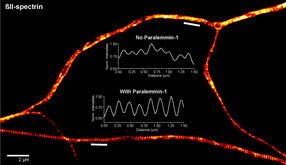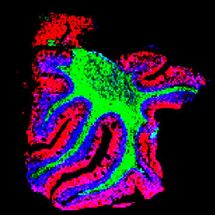Infrared light to detect early signs of esophageal cancer
Scientists have developed an endoscope that uses near-infrared light to spot early warning signs of oesophageal - food pipe - cancer, according to research.
Researchers at the Cancer Research UK Cambridge Institute sprayed a dye on oesophageal tissue samples taken from people with Barrett's oesophagus - a condition that increases the risk of developing oesophageal cancer. The dye sticks to healthy oesophageal cells but not to pre-cancerous cells.
They then shone near-infrared light on the tissue, which is just beyond the red colours that our eyes can normally see, and used a special camera to detect the near-infrared light the dye gave out.
Researchers had tried this approach before but had used a dye that gave out visible light to spot pre-cancerous cells. Problems arose because when cells are exposed to visible light, they naturally emit visible light themselves - making the distinction between healthy and abnormal cells hard to see.
But, by using a dye that gives out near-infrared light, scientists refined the process so they could make the distinction.
This new technique could be used to monitor people with Barrett's oesophagus who have an increased risk of developing oesophageal cancer, and spot early signs that cancer might be developing before the person has any symptoms.
Dr Sarah Bohndiek, scientist at the Cancer Research UK Cambridge Institute, said: "This research gives us hope for developing better techniques to detect the disease early.
"People who are at a high risk of developing oesophageal cancer, such as those with Barrett's oesophagus, could be closely monitored with this technique. And removing patches of pre-cancerous cells could prevent some cases of oesophageal cancer. But we need to do some further testing before clinical trials with patients can be set up to see how effective the approach could be at saving lives."
There are around 7,800 deaths from oesophageal cancer every year in the UK. For men, oesophageal cancer is the fourth most common cause of cancer death.
Dr Emma Smith, science communication manager at Cancer Research UK, said: "Early detection is crucial if we want to cure more cancers and save more lives. And oesophageal cancer is often caught at an advanced stage, meaning survival rates of the disease have remained stubbornly low.
"We urgently need new ways to detect the disease early. This development could lead to a cheaper, better way of detecting the warning signs of oesophageal cancer and even stop some people developing the disease."
Original publication
Original publication
Dale J. Waterhouse, James Joseph, André A. Neves, Massimiliano di Pietro, Kevin M. Brindle, Rebecca C. Fitzgerald, Sarah E. Bohndiek; "Design and validation of a near-infrared fluorescence endoscope for detection of early esophageal malignancy"; J. Biomed. Opt.; 2016
Organizations
Other news from the department science

Get the life science industry in your inbox
By submitting this form you agree that LUMITOS AG will send you the newsletter(s) selected above by email. Your data will not be passed on to third parties. Your data will be stored and processed in accordance with our data protection regulations. LUMITOS may contact you by email for the purpose of advertising or market and opinion surveys. You can revoke your consent at any time without giving reasons to LUMITOS AG, Ernst-Augustin-Str. 2, 12489 Berlin, Germany or by e-mail at revoke@lumitos.com with effect for the future. In addition, each email contains a link to unsubscribe from the corresponding newsletter.






















































